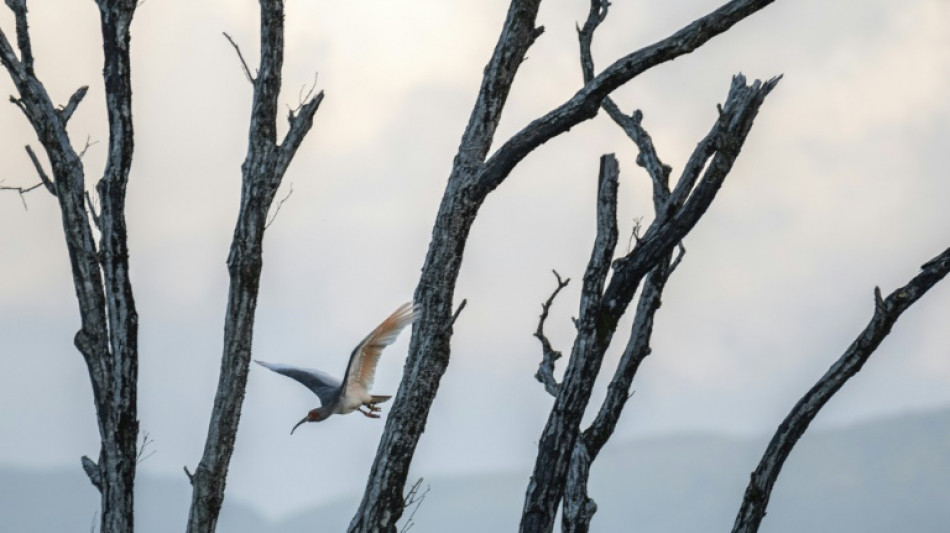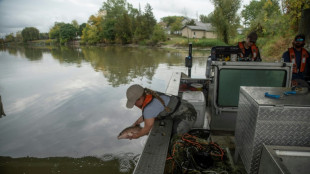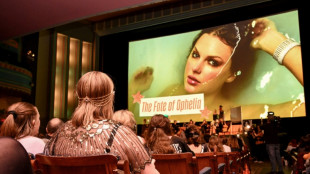
-
 Georgia PM announces sweeping crackdown on opposition after 'foiled coup'
Georgia PM announces sweeping crackdown on opposition after 'foiled coup'
-
Syria selects members of first post-Assad parliament

-
 Russian strikes kill five in Ukraine, cause power outages
Russian strikes kill five in Ukraine, cause power outages
-
World champion Marquez crashes out of Indonesia MotoGP

-
 Babis to meet Czech president after party tops parliamentary vote
Babis to meet Czech president after party tops parliamentary vote
-
Death toll from Indonesia school collapse rises to 37

-
 OPEC+ meets with future oil production hanging in the balance
OPEC+ meets with future oil production hanging in the balance
-
Dodgers down Phillies on Hernandez homer in MLB playoff series opener

-
 Philadelphia down NYCFC to clinch MLS Supporters Shield
Philadelphia down NYCFC to clinch MLS Supporters Shield
-
Syria selects members of first post-Assad parliament in contested process

-
 Americans, Canadians unite in battling 'eating machine' carp
Americans, Canadians unite in battling 'eating machine' carp
-
Negotiators due in Cairo for Gaza ceasefire, hostage release talks

-
 Trump authorizes troops to Chicago as judge blocks Portland deployment
Trump authorizes troops to Chicago as judge blocks Portland deployment
-
Wallabies left ruing missed chances ahead of European tour

-
 Higgo stretches PGA Tour lead in Mississippi
Higgo stretches PGA Tour lead in Mississippi
-
Blue Jays pummel Yankees 10-1 in MLB playoff series opener

-
 Georgia ruling party wins local polls as mass protests flare
Georgia ruling party wins local polls as mass protests flare
-
Depoortere stakes France claim as Bordeaux-Begles stumble past Lyon

-
 Vinicius double helps Real Madrid beat Villarreal
Vinicius double helps Real Madrid beat Villarreal
-
New museum examines family life of Mexican artist Frida Kahlo

-
 Piccioli sets new Balenciaga beat, with support from Meghan Markle
Piccioli sets new Balenciaga beat, with support from Meghan Markle
-
Lammens must be ready for 'massive' Man Utd scrutiny, says Amorim

-
 Arteta 'not positive' after Odegaard sets unwanted injury record
Arteta 'not positive' after Odegaard sets unwanted injury record
-
Slot struggles to solve Liverpool problems after third successive loss

-
 Netanyahu hopes to bring Gaza hostages home within days as negotiators head to Cairo
Netanyahu hopes to bring Gaza hostages home within days as negotiators head to Cairo
-
Ex-NFL QB Sanchez in hospital after reported stabbing

-
 Liverpool lose again at Chelsea, Arsenal go top of Premier League
Liverpool lose again at Chelsea, Arsenal go top of Premier League
-
Liverpool suffer third successive loss as Estevao strikes late for Chelsea

-
 Diaz dazzles early and Kane strikes again as Bayern beat Frankfurt
Diaz dazzles early and Kane strikes again as Bayern beat Frankfurt
-
De Zerbi living his best life as Marseille go top of Ligue 1

-
 US envoys head to Mideast as Trump warns Hamas against peace deal delay
US envoys head to Mideast as Trump warns Hamas against peace deal delay
-
In-form Inter sweep past Cremonese to join Serie A leaders

-
 Kolisi hopes Rugby Championship success makes South Africa 'walk tall' again
Kolisi hopes Rugby Championship success makes South Africa 'walk tall' again
-
Ex-All Black Nonu rolls back the years again as Toulon cruise past Pau

-
 Hundreds of thousands turn out at pro-Palestinian marches in Europe
Hundreds of thousands turn out at pro-Palestinian marches in Europe
-
Vollering powers to European women's road race title

-
 Struggling McLaren hit bump in the road on Singapore streets
Struggling McLaren hit bump in the road on Singapore streets
-
'We were treated like animals', deported Gaza flotilla activists say

-
 Czech billionaire ex-PM's party tops parliamentary vote
Czech billionaire ex-PM's party tops parliamentary vote
-
Trump enovys head to Egypt as Hamas agrees to free hostages

-
 Arsenal go top of Premier League as Man Utd ease pressure on Amorim
Arsenal go top of Premier League as Man Utd ease pressure on Amorim
-
Thousands attend banned Pride march in Hungarian city Pecs

-
 Consent gives Morris and Prescott another memorable Arc weekend
Consent gives Morris and Prescott another memorable Arc weekend
-
Georgian police fire tear gas as protesters try to enter presidential palace

-
 Vollering powers to European road race title
Vollering powers to European road race title
-
Reinach and Marx star as Springboks beat Argentina to retain Rugby Championship

-
 Russell celebrates 'amazing' Singapore pole as McLarens struggle
Russell celebrates 'amazing' Singapore pole as McLarens struggle
-
Czech billionaire ex-PM's party leads in parliamentary vote

-
 South Africa edge Argentina to retain Rugby Championship
South Africa edge Argentina to retain Rugby Championship
-
'Everyone's older brother': Slipper bows out in Wallabies loss


Modern phoenix: The bird brought back from extinction in Japan
Every day for the past 14 years, 72-year-old Masaoki Tsuchiya has set out before sunrise to search for a bird rescued from extinction in Japan.
Starting his car under star-dotted skies unpolluted by light, he works alone in the pre-dawn chill, marking sightings or absences in a planner, interrupted only by the crackle of a walkie-talkie.
The bird he is looking for is called "toki" in Japanese, and its presence on his home of Sado island is testament to a remarkable conservation programme.
In just under two decades, Japan's population of wild toki has gone from zero to nearly 500, all on Sado, where the bird's delicate pink plumage and distinctive curved beak now draw tourists.
It's a rare conservation success story when one in eight bird species globally are threatened with extinction, and involved international diplomacy and an agricultural revolution on a small island off Japan's west coast.
- A cautionary tale -
Tsuchiya, stocky and spry with an impish grin, doesn't eat breakfast until he has made all his stops, and after years of practice he can spot chicks hidden in nests through the monocular attached to his rolled-down car window.
He points to virtually imperceptible marks on a road or a wall that help him remember where to park and start surveying.
"The number I see at this spot depends on the season," he explains.
Some days dozens of the birds appear in one area, something unimaginable in 2003, when a toki called Kin or "gold" died in a cage on Sado at the record-breaking age of 36.
Her death meant not a single wild-born toki was left in Japan, despite the bird being so synonymous with the country that it is also known as the Japanese crested ibis.
"I knew the day was coming. She was very old and frail," Tsuchiya said. "But it was still a real pity."
Efforts to get Kin to mate with Sado's last wild-born male toki Midori -- meaning "green" -- had long since failed, and she lived out her last years as a curiosity and a cautionary environmental tale.
Her death made national headlines and appeared to mark the end of a long and seemingly futile battle to protect the toki in Japan, where its feathers even inspire the word for peach pink: "toki-iro".
But now so many roam the skies and rice paddies of Sado that local officials have gone from discouraging eager birdwatchers to training guides to help visitors spot the local icon, and the government is even studying reintroducing the bird elsewhere.
- Wiped out -
Wild toki once lived across Japan, as well as in Russia, Taiwan and South Korea.
They were considered a pest that damaged rice plants, but during Japan's Edo era, from 1603 to 1867, hunting restrictions meant only high-ranking officials could actively pursue birds like toki.
That changed in the Meiji era and as guns became more available. Toki meat was believed to have health benefits, and its feathers were favoured for everything from dusters to decorative flourishes on hats.
"Over just 40 years, the toki basically disappeared," said Tsuchiya on an observation deck where visitors now try to spot the bird.
By the early 1930s, only a few dozen toki remained in Japan, mostly on Sado and the nearby Noto peninsula, and the species won protected status.
A fresh threat then emerged during Japan's post-war drive for growth: rising use of chemical fertilisers and pesticides.
Toki feed primarily in rice paddies that mimic marshy wetland habitats and they are undiscriminating diners, eating everything from insects to small crabs and frogs.
The chemicals affected the birds and their food, and by 1981 just five wild toki remained in Japan, all on Sado, where officials took them into protective captivity.
But by bizarre coincidence, the same year a population of seven wild toki was discovered in a remote area of China's Shaanxi province, reviving hopes for the bird's survival.
Sado's captive birds failed to mate, but China's programme had more success, and when then-Chinese president Jiang Zemin made a historic first state visit in 1998 he offered Japan the gift of a pair of toki.
You You and Yang Yang arrived the following year on first-class seats, producing their first chick months later in an event that led national television broadcasts.
Other birds arrived from China, and with time Sado had a large enough population to consider reintroducing the toki to the wild.
But first they had to tackle the use of chemical fertilisers and pesticides on Sado.
"Back then people didn't think about the environment when farming. Their priorities were selling products at a high price and harvesting as much as possible," said Shinichiro Saito, a 60-year-old rice farmer.
Farmers were asked to cut chemical fertilisers and pesticides by half from the level allowed by local rules, but there was pushback.
Fewer chemicals meant smaller harvests, lost income, and more weeding.
And some farmers couldn't see the point of other proposals like underground channels connecting rice fields to rivers to increase the flow of aquatic life.
- 'Toki-friendly' -
Local officials used a carrot-and-stick approach, refusing to buy rice from farmers who rejected the new chemical limits and creating a new premium brand of "toki-friendly" rice for those who did.
But Saito, who was an early adopter, said the real difference came when the first birds were released in 2008.
"It was the toki that changed their minds," he said, with a lop-sided grin.
Even farmers reluctant to adapt were "delighted" to see a bird with almost mythical status on Sado wandering through their fields.
"This is a true story. The toki was almost like an environmental ambassador, it helped create a good environment for itself."
Tsuchiya's daily rounds began with the 2008 release.
He has since witnessed triumphs including the first wild-born chick, and the first chick born to wild-born birds -- moments he describes with the proud anxiety of a parent sending a child off to school for the first time.
He still runs his own business, though the toki feather tucked into his car's folding mirror makes clear where his heart lies.
And the breeding programme has continued, supplemented by birds from China that help broaden the gene pool.
Around 20 birds are released twice a year after graduating from a three-month training programme that prepares them for life outside a cage.
"They learn how to fly, how to find food and to get used to being around humans," explained Tomoki Tsuchiya, who works with Sado's local government to make the island toki-friendly.
City officials even farm around the birds to acquaint them with the sound.
- 'Like family' -
When the first toki were released on Sado, there were so many gaps in knowledge about the species that volunteers analysed their droppings to find out what the birds were eating.
There were missteps: officials prepared a remote mountain location for the release, believing the birds would prefer seclusion, but the toki instead flew down to fields that were frequented by farmers.
Tomoki Tsuchiya's interest in toki was fostered by his father, Masaoki.
But it is a fascination shared by many on Sado, where the bird is rendered in cute mascot form on everything from T-shirts to milk cartons.
"How can I express it? The toki is so important for people on Sado," the 42-year-old said.
"It's like family."
Even after training, a toki's future is precarious: only about half survive predators like snakes and weasels, and the survival rate for newborn chicks is similar.
But enough have thrived that Japan may expand the Sado programme, and there have been successes elsewhere.
China's wild population now numbers over 4,450, and a South Korean project released 40 toki for the first time in 2019.
For Saito, who speaks as toki squawk nearby, the bird's resurrection is part of a bigger achievement on Sado -- a new approach to farming and the environment.
"When this project started, what I dreamed of the most was seeing toki flying overhead while I farmed," he said.
"An environment that is good for toki is an environment that is also safe for humans, and that's something people on Sado can be proud of."
T.Bondarenko--BTB



